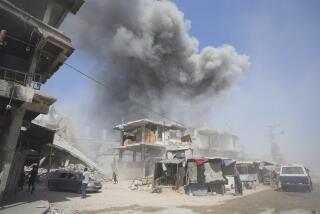U.N. Force Caught Between Iraq and Kuwait
- Share via
CAMP KHOR, Between Kuwait and Iraq — For a dozen years, U.N. military observers have been standing guard along this 125-mile-long demilitarized zone to keep soldiers on either side from crossing the border.
As the United States continues massing tens of thousands of troops in Kuwait for a possible invasion of Iraq, the United Nations is planning for a possible evacuation of its 1,300 personnel here to Italy or Bangladesh.
“For the time being we will stay on the ground,” Daljeet S. Bagga, spokesman for the U.N. Iraq-Kuwait Observation Mission, or UNIKOM, said Monday. “But we have contingency plans.”
If an invasion occurs, the troops might drive past 11 U.S. Army officers assigned to the multinational force manning observation posts that peer over the zone, which extends three miles into Kuwait and six miles into Iraq.
“It’s going to be a lonely feeling,” said Army Maj. Bob Paddock, assigned to the post dubbed November 9. “I guess I can wave at them as they roll past.”
If President Bush orders an invasion without a resolution having been passed by the U.N. Security Council, and U.S. forces pass through the DMZ on their way to Iraq, the United States would be violating the U.N. mandate that the zone stay free of military troops who are not serving as observers.
But as a matter of military tactics, breaching the zone -- created after a U.S.-led coalition routed the Iraqi army in 1991 and ended Baghdad’s occupation of Kuwait -- would not pose much of a problem.
The Kuwaiti government controls 19 gates leading into the zone, including one at the end of Highway 80, the main thoroughfare between Kuwait and Iraq. The road was known as the “Freeway of Death” in 1991 when the U.S. and its allies destroyed hundreds of Iraqi vehicles being driven by fleeing troops who refused to surrender.
An electrified fence stretches the length of the zone from the Iraqi port city of Umm al Qasr on the Persian Gulf to the border with Saudi Arabia. That fence and others, along with berms and trenches, could be easily overcome by U.S. Army soldiers and Marines trained in clearing obstacles for infantry troops, military officials say. The Marine Corps has brought an elite unit of combat engineers from the 1st Marine Division, headquartered at Camp Pendleton.
One immediate objective of the U.S. force could be to capture the Iraqi city of Basra, 28 miles north of the border, and engage the Iraqi army division headquartered there.
While U.S. military strategists in camps throughout the Kuwaiti desert may be mapping plans on how to push quickly into Iraq, life in the DMZ remains quiet.
“We are in the eye of the storm,” said Argentine army Capt. Jose Ferraro, commander of the seven-man contingent at November 9.
About 200 military observers from more than 30 nations are responsible for the observation posts from which the sandy, rocky expanse is watched. An estimated 10,000 Iraqis live inside the zone, most of them subsistence farmers.
The observers, who are unarmed, are backed by 775 infantry troops and a 36-member helicopter squadron from Bangladesh, along with 50 engineers and a 30-member logistics squad from Argentina. Germany has contributed a 14-person civilian medical staff. The commander of the mission is a Polish major general.
Two-thirds of the annual $56-million cost of the mission is paid by the Kuwaiti government. Attempts to breach the zone’s border on land are rare. In a six-month period last year, only 20 land incidents occurred.
Occasionally an Iraqi farmer is spotted using an off-limits road that parallels the border. Iraqi military personnel have been seen riding in the zone, and an Iraqi camel herder got into a fight with Kuwaiti police at one of the gates.
The most common Iraqi allegation complains of U.S. and British flights over the demilitarized zone. The Iraqis have made hundreds of complaints through the UNIKOM officer assigned to Baghdad.
The answer to the Iraqis is always the same: The mission lacks the technology to determine just what airplane is flying above. The response is known to gall the Iraqis.
Sick and injured Iraqis sometimes defy Baghdad by coming to the gates seeking help from the German medical team. “Many had traveled for quite a long time and over long distances,” according to a U.N. report.
Land mines are a danger on the Iraqi side of the zone and beyond. Several children have been injured by mines, and a 12-year-old was killed in recent months.
In 1993, Iraq provoked a mini-crisis when its soldiers ventured into the zone to retrieve what they said was military gear. In 2000, a protest was held at the border by stateless Arabs who fled from Kuwait to Iraq during the 1990-91 occupation and then were refused permission to return. A brief moment of high drama came last December when Baghdad returned artwork stolen during the occupation to Kuwaiti officials who went to the Iraqi side of the zone.
For the most part, however, duty there has been uneventful. The summer, said Turkish Maj. Inkay Nerat, “is a long season of heat, snakes and scorpions.”
The zone’s placid nature could change dramatically in coming weeks. Paddock, an infantry platoon leader during the 1991 Persian Gulf War, has asked Army brass whether he should join one of the U.S. units if they rush northward.
But British Maj. Stephen Prosser said he would prefer to stay put even if British units, as expected, are part of an invasion force. “When you’re in the army,” he said, “you have to stick to the job you’ve been given even when things change.”
More to Read
Sign up for Essential California
The most important California stories and recommendations in your inbox every morning.
You may occasionally receive promotional content from the Los Angeles Times.













